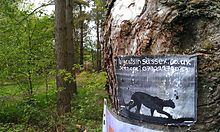
In British folklore and urban legend, British big cats refers to the subject of reported sightings of non-native, wild big cats in the United Kingdom. Many of these creatures have been described as "panthers", "pumas" or "black cats".
There have been rare isolated incidents of recovered individual animals, often medium-sized species such as the Eurasian lynx, though in one 1980 case, a puma was captured alive in Scotland.[1] These are generally believed to have been escaped or released exotic pets that had been held illegally, possibly released after the animals became too difficult to manage or after the introduction of the Dangerous Wild Animals Act 1976.[2]
The existence of a population of "true big cats" in Britain, however, especially a breeding population, has been rejected by experts and the British government owing to a lack of convincing evidence for the presence of these animals.[3][4] Supposed sightings made from a distance have been largely written off as domestic cats close to the subject being misidentified as a larger animal sited farther away,[5][6] with one folklorist considering such sightings of creatures to be little more than a "media artifact" driven by British journalistic practices in the 1970s and 1980s[7] while another described it as the result of a situation where "media-generated interest encourages rumour, misinterpretation, and exaggeration".[8]

- ^ Strachan, Graeme (28 October 2020). "Big cats: The hunt for the puma caught roaming the Highlands in 1980". Press and Journal. Retrieved 30 October 2020.
- ^ "Essex lion: Charting the big cats of Britain". BBC News. 28 August 2012.
- ^ Wilding, Mark (14 April 2019). "On the trail of Britain's wild big cats". The Guardian. Retrieved 19 September 2022.
A spokeswoman for the Department for Environment, Food & Rural Affairs (Defra) said: "Neither Natural England nor Defra have received any credible reports of wild living or breeding big cats in Britain in recent years. Defra is not currently engaged in any work related to the management of wild big cats in Britain and has no plans to do so."
- ^ Franklin, Adrian (2016). "Far from the madding crowd: Big cats on Dartmoor and in Dorset, UK". In Hurn, Samantha (ed.). Anthropology and Cryptozoology. Routledge. ISBN 978-1315567297.
According to recent accounts by social scientists and environmentalists (widely supported by scientists and governmental agencies), most claims and beliefs about the presence of so-called 'alien big cats' (henceforth big cats) in Britain are largely imagined fantasies, social constructions and media-driven hysterias (Buller 2004; 2009; Monbiot 2013).
- ^ Hambling, David (19 July 2001). "It's a lion... no it's a cat". The Guardian. Retrieved 3 September 2015.
- ^ "The mystery of Britain's alien big cats". The Week. 25 August 2014. Retrieved 4 July 2023.
- ^ Goss, Michael (1992). "Alien Big Cat Sightings in Britain: A Possible Rumour Legend?" (PDF). Folklore. 103 (2): 184–202. doi:10.1080/0015587X.1992.9715841. ISSN 0015-587X. JSTOR 1260889.
- ^ Simpson, Jacqueline; Roud, Stephen (2000). A Dictionary of English Folklore. Oxford University Press. ISBN 978-0-19-210019-1.